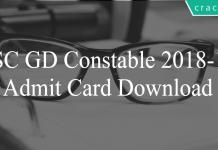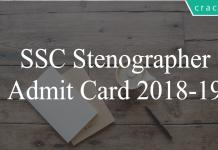Number System Questions for SSC CGL Tier – 2 PDF
Download SSC CGL Tier 2 Number System Questions PDF. Top 15 questions based on asked questions in previous exam papers very important for the SSC exam.
Download Number System Questions for SSC CGL Tier – 2 PDF
Get 10 SSC CGL Tier-2 Mocks for Rs. 149
Take SSC CGL Tier-2 Mock Tests
Download SSC CGL Tier-2 Previous Papers PDF
Question 1: A 4-digit number is formed by repeating a 2-digit number such as 1515, 3737, etc. Any number of this form is exactly divisible by
a) 7
b) 11
c) 13
d) 101
Question 2: A number, when divided by 136, leaves remainder 36. If the same number is divided by 17, the remainder will be
a) 9
b) 7
c) 3
d) 2
Question 3: The sixth term of the sequence 2, 6, 11, 17 is
a) 24
b) 30
c) 32
d) 36
Question 4: If a and b be positive integers such that $a^2-b^2 = 19$, then the value of a is
a) 19
b) 20
c) 9
d) 10
Question 5: A number, when divided by 114, leaves remainder 21. If the same number is divided by 19, then the remainder will be
a) 1
b) 2
c) 7
d) 17
Question 6: The ninth term of the sequence 0, 3, 8, 15, 24, 35, is
a) 63
b) 70
c) 80
d) 99
Take SSC CGL Tier-2 Mock Tests
Download SSC CGL Tier-2 Previous Papers PDF
Question 7: The greatest number, which when subtracted from 5834, gives a number exactly divisible by each of 20, 28, 32 and 35, is
a) 1120
b) 4714
c) 5200
d) 5600
Question 8: A student was asked to divide a number by 6 and add 12 to the quotient. He, however, first added 12 to the number and then divided it by 6, getting 112 as the answer. The correct answer should have been
a) 124
b) 122
c) 118
d) 114
Question 9: When ‘n’ is divided by 5 the remainder is 2. What is the remainder when n2 is divided by 5?
a) 2
b) 3
c) 1
d) 4
Question 10: Which one of the following will completely divide 571 + 572 + 573 ?
a) 150
b) 160
c) 155
d) 30
Question 11: The unit digit in the product $122^{173}$ is
a) 2
b) 4
c) 6
d) 8
Download SSC CGL General Science Notes PDF
Question 12: I multiplied a natural number by 18 and another by 21 and added the products. Which one of the following could be the sum?
a) 2007
b) 2008
c) 2006
d) 2002
Question 13: If’n’ be any natural number. then by which largest number $(n^3 – n)$ is always divisible ?
a) 3
b) 6
c) 12
d) 18
Question 14: Out of six consecutive natural numbers, if the sum of first three is 27, what is the sum of the other three ?
a) 36
b) 35
c) 25
d) 24
Question 15: If p and q represent digits, what is the possible maximum value of q in the statement 5p9 + 327 + 2q8= 1114?
a) 9
b) 8
c) 7
d) 6
18000+ Questions – Free SSC Study Material
Free SSC Preparation (Videos Youtube)
Answers & Solutions:
1) Answer (D)
let’s say digit is pqpq
or pq00 + pq
or pq*100 + pq
or pq (100 + 1)
or pq (101)
hence digit will always be divisible by 101
2) Answer (D)
Number will be (136n + 36) where n is quotient
hence when it is divided by 17 remainder for $\frac{136n +36}{17}$ will be 2 as 136 is divisible by 17 and 36=34+2
3) Answer (C)
As we can see there difference of the sequence is in arithmatic progression of difference 1
Second term = first term + 4
Third term = second term + 5
Fourth term = third term + 6
nth term = (n-1)th term + (4 + (n-1)*1)
Adding above equation we get
nth term = first term + (4+5+6….+(3+(n-1)))
hence 6th term will be 32.
4) Answer (D)
$a^2-b^2 = 19$
19 is a prime number
(a + b)(a – b) = 19 x 1
So a + b = 19
a – b = 1
Adding both the equations we get 2a = 20
a = 10
5) Answer (B)
Let the given number be x
Let a be the quotient when x is divided by 114
So $\frac{x}{114}$ = a$\frac{21}{114}$
so x = 114a + 21
when x is divided by 19 it can be written as
$\frac{x}{19} = \frac{114a + 21}{19}$
114 is divisible by 19 and 21 leaves a remainder of 2.
6) Answer (C)
Given:
Sequence of numbers 0,3,8,15,24,35
To know:
9th term of the sequence
As we can see difference of sequence is in arthmatic progression of 3,5,7,9,11,13 and so on.
6th term of sequence is 35
and adding common difference for it (that is 13) , hence 7th term will be 48
accordingly 9th term will be 80
7) Answer (B)
Given: Numbers- First = 5834
Second = x (Suppose)
And number (5834 – x) is divisible by each of 20,28,32,35
Let’s say it is y
Hence 5834 – x = y
or x = 5834 – y
Now for x to be greatest y should be least
hence y should be least common multiple of 20,28,32,35
y = 1120
now x = 5834 – 1120
x = 4714
8) Answer (B)
Let’s say number is N
So according to student result is $112= \frac{N+12}{6} $
or N = 660
Correct answer will be = $\frac{660}{6} +12 = 110+12 = 122$
9) Answer (D)
n = 5k+2 (where k is quotient )
so $n^2 = 25k^2 + 4 + 20k$
Now when $n^2$ will divided by 5 , remainder will be 4.
10) Answer (C)
Among all options only option C has unit digit 5, and in given equation unit digit will also be 5.
So only 155 can divide the given equation completely.
11) Answer (A)
As we know a number with unit digit 2 have repeating cycle of 2,4,8,6 after every fourth power
as power is 173 or (172+1) where till 172 , 43rd cycle will get complete and next unit digit will be 2.
12) Answer (A)
let’s say one number is n and another number is p
so acc. to question sum will be 18n+21p
and this number will be divisible by 3 so answer will be (A)
13) Answer (B)
$(n^{3} – n) $ can be written as n(n-1)(n+1)
for n to be any natural number, $n^{3} – n$ is a product 3 consecutive numbers starting from 1.
hence for any value of a min. product of 6 will be there hence it is always be divisible by 6.
14) Answer (A)
let’s say 6 consecutive numbers are (a-d), a, (a+d), (a+2d), (a+3d), (a+4d)
where d is the common difference i.e. 1 (given) and a is second term
summation of first three terms will be 3a = 27
hence second term a = 9
now sequence is 8,9,10,11,12,13,
so sum of last three terms 36
15) Answer (C)
We can break the sum according to 500 + 10p +9 + 327 + 200 + 10q + 8 = 1114
or 1027 + 17 + 10(p+q) = 1114
or (p+q) = 7
so for q to be maximum p will be zero then q = 7
DOWNLOAD APP FOR SSC FREE MOCKS
We hope this Number System Questions pdf for SSC CGL Tier 2 exam will be highly useful for your Preparation.





